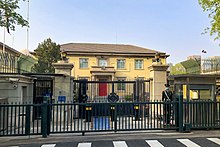Embassy of the United Kingdom, Beijing
| British Embassy, Beijing | |
|---|---|
 The Embassy building in Beijing | |
 | |
| Location | |
| Address | 11 Guang Hua Lu, Jian Guo Men Wai, 100600 Beijing, China |
| Coordinates | 39°54′45″N116°26′32″E/ 39.9124°N 116.4423°E |
| Ambassador | Caroline Wilson |
| Website | British Embassy, Beijing |
TheEmbassy of the United KingdominBeijing(orBritish Embassy, Beijing) is the chiefdiplomatic missionof theUnited Kingdomin thePeople's Republic of China.It is one of Britain's largest overseas embassies.[1]It is located at 11 Guanghua Road, in theChaoyang District.The current British Ambassador to China isCaroline Wilson.[2]
History[edit]
The old British legation was established on 26 March 1861 in the former palace of Duke I-liang andSir Frederick Brucebecame the first “Envoy Extraordinary and Minister Plenipotentiary” to Imperial China to reside in Beijing.[3]Considering the place substandard, work began to find a replacement, and the legation was moved to "Leang-Koong-foo" (the Duke of Leang's palace) in 1866, where it would stay until 1959.[4][5]
In 1959 the Chinese authorities required the British to vacate their location as they wanted to redevelop the land for use as theSupreme People's Court.In January 1959 the British were informed that "the centre of Peking was scheduled for reconstruction and that the area occupied by the British Legation was required for the site of a large new building for the Judicial Executive. The staff of the Legation was therefore requested to move out of their quarters by May 31st 1959”.[6]In exchange for vacating their old premises in 1959, the Chinese authorities built and offered the British their current embassy and residence in the diplomatic district. The embassy consists of two two-storey houses set in walled gardens.[6]Another reason was that the building was symbolic of theunequal treatiesand thecentury of humiliationfor many Chinese, so shifting to a new one would help shed that historical baggage.[7]
During theCultural Revolutionand at the tail-end of the1967 Hong Kong riots,theRed Guardsstormed the premises, looted the Office of British Chargé d'Affaires (predecessor body of embassy) and burnt it on 23 August.[8]
Other locations[edit]
The consular section is now too large to be accommodated in the embassy building (referred to locally as the 'main building'). It is now housed at the Kerry Centre, 1 kilometer away. Visa applications are handled at a centre shared withIrelandat Chaoyangmen.
Outside Beijing, there are also Britishconsulates generalinGuangzhou,Wuhan,ChongqingandShanghaiwhere the senior officer is known as the consul-general.[2]There is also aBritish consulate-general in Hong Kong(the largest British consulate-general in the world), responsible for maintaining British ties withHong Kong[9]andMacao.[10]However, due to Hong Kong'sunique status,the consul-general reports directly to the China Department of theForeign and Commonwealth Office,instead of going through the British ambassador in Beijing.[11]
See also[edit]
- China-United Kingdom relations
- Embassy of China, London
- List of Ambassadors of the United Kingdom to China
References[edit]
- ^"Our embassy".Government Internet Archive.Archived fromthe originalon 17 February 2013.Retrieved20 March2015.
- ^ab"British Embassy Beijing".FCO.gov.uk.Retrieved19 March2015.
- ^Cranmer-Byng 1963,p. 60.
- ^Cranmer-Byng 1963,p. 65.
- ^Huang, Hsin-Yin (April 2010).Going native: British diplomatic, judicial and consular architecture in China (1867-1949)(PDF)(Doctor of Philosophy). University of Sheffield.
- ^ab"The Embassy and milestones".Government Internet Archive.Archived fromthe originalon 17 February 2013.Retrieved20 March2015.
- ^Cranmer-Byng 1963,p. 87.
- ^Fairbank, John King; Goldman, Merle (2006).China: A New History, Enlarged Edition.Harvard University Press. p. 396.ISBN978-0-674-01828-0.
- ^UK in Hong Kong - the British Consulate-General Hong Kong and Macao
- ^UK in Macao
- ^The UK's relations with Hong Kong: 30 years after the Joint Declaration,Tenth Report of Session 2014–15,Foreign Affairs Select Committee,House of Commons,6 Mar 2015, page 16PDF
Bibliography[edit]
- Cranmer-Byng, J. L. (1963)."THE OLD BRITISH LEGATION AT PEKING, 1860-1959: Based on a lecture delivered on 20 August, 1962".Journal of the Hong Kong Branch of the Royal Asiatic Society.3:60–87.ISSN0085-5774.JSTOR23881292.
